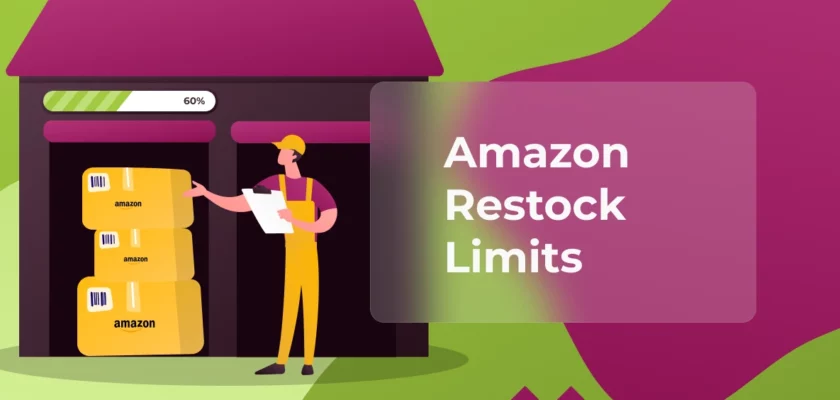Table of Contents
 Online commerce has grown rapidly within the past years. That is especially true for Amazon. Nevertheless, that growth spurt came with plenty of growing pains.
Online commerce has grown rapidly within the past years. That is especially true for Amazon. Nevertheless, that growth spurt came with plenty of growing pains.
Increased market demand because of the COVID-19 pandemic resulted in shipping restrictions last spring. Later in 2021, AMZ introduced its ASIN-level quantity limits for certain FBA goods. With a limited quantity of units per ASIN that one can send to the marketplace, many merchants found themselves shifting quickly to deliver to their own warehouse or a third-party 3PL instead of straight to FBA.
Now, ASIN-level restrictions have been stopped. However, Amazon restocks limits are applied at the seller account level and by inventory type. This change became effective in April 2021, as merchants were preparing for Prime Day, resulting in many scrambling to adjust once again.
Keep on reading to learn everything you need to know about Amazon restock limits by storage type.
What Are Restock Limits on Amazon?
Amazon restocks limits basically limit your entire account’s product quantity and inventory. However, it hasn’t always been so.
Before, the platform used to only restrain how many products you could ship for each ASIN listed. It meant merchants could have unlimited storage if they had different ASINs and product listings.
Nevertheless, in April 2021, it all changed. The marketplace decided to substitute ASIN-level quantity limitations with Amazon restock limits by storage types based on reviews from the seller community. Those new restrictions applied account-wide and allowed merchants to send and keep FBA stock depending on whether their items were standard-sized, oversized, or classified as apparel, footwear, flammable, or aerosol.
In 2022, Amazon FBA restocks limits and continues to observe the same criteria. They allow new merchants to send a maximum of 1000 units of FBA shipments under each storage type. It is a relief compared to the limitations imposed under the old AMZ 200 quantity limit.
Still, if you have been working on the platform and searching to add a new item to your catalog, the Amazon storage limit may influence your launch, especially when you’re already selling products of the same type. Your old merchandise and in-transit shipments can take up a big chunk of your current limits, leaving very little for the new products.
It’s a challenge experienced merchants must overcome.
How to See Your Amazon FBA Restock Limits?
In your Seller Central, you may monitor restock limits on the Shipping Queue or Inventory Performance sections. Scroll to the bottom of the webpage and proceed to the Restock Limits and Storage Volume menu to find your quantity by storage type.
Keep in mind that your inventory utilization helps the marketplace determine your highest shipment amount. It also counts against the maximum inventory level. It includes current FBA stock as well as all incoming loads (including Working, Receiving, and Transit statuses).
If you have inventory pending or reserved inventory removals, those products are not included in this calculation.
How Can You Better Manage Your Products with Restock Limits?
This section covers some recommendations to help you best manage your stock with Amazon limits.
Lower utilization
As your maximum delivery quality equates to your highest inventory level minus utilization, decreasing utilization will help you keep more space for new products.
You may do this by reducing the amount of stock you have in Amazon’s fulfillment centers or by withdrawing open shipments for items that you don’t plan to send to the marketplace.
A great practice to monitor your utilization is by checking your account’s Shipping Queue. You can see or cancel any open deliveries in this tab. All you need to do is click any shipment name (or Track shipment or View shipment), then choose Delete shipment or Cancel shipment.
Restock popular items to boost sales and expand your business
Growing your sales results in a higher restock limit. So, by replenishing your popular items, you can sell more units and thus enhance your business.
If you visit the Restock Inventory tab on your Seller Central account, you can check the recommended replenishment amount for each ASIN and replenish them promptly.
This feature is convenient to help you schedule how many products you should send to the AMZ FBA fulfillment centers and when to do it. Such recommendations are displayed in two columns: Recommended replenishment quantity and Recommended ship date.
You can also find out if your recommendations are within the Amazon FBA restock limits.
Decrease your stock in fulfillment centers
It’s the most straightforward of all the recommendations. Simply reducing your stock in the platform’s fulfillment centers will let you have more capacity for more product units.
Check out a few simple steps you may do this:
- Increase your sales. In the Manage Inventory Health tab, you can find recommendations on increasing your sales. It’s a great option as it helps you make the right decisions about your aged and excess inventory. Besides, you may use Multi-Channel Fulfillment to move your inventory to other selling channels, such as your own site.
- Request to have your stock disposed of by applying for a disposal order. You may do this under your Manage Inventory page.
- Request to have your stock returned to you by making a removal order in the same section.
How to Increase Amazon Restock Limits?
Fortunately, merchants can take some steps to extend their Amazon restocks limits. The online giant regularly revises FBA quantity restrictions depending on sellers’ performance. Here’s what you can do:
- Generate more sales
Amazon uses your sales history to calculate your restock limit. So if you can generate more orders, there’s a high chance your highest inventory limit may get a pleasant little bump on the next platform’s review.
- Optimize your product listings for higher conversions and visibility
- Run PPC advertising campaigns to boost your paid sales
- Bring external traffic to your AMZ store
- Use A+ Content
- Generate more Amazon reviews
Pro tip: Leverage third-party tools to simplify feedback management. Mailer has done a great job when it comes to developing a powerful AMZ service popular among merchants. It allows sellers to send review requests, track their product ASINs’ testimonials, and generate VAT invoicing on the EU AMZ marketplaces – all in a single subscription!
- Use the AMZ global seller program to offer your product in other markets
- Price your items competitively
- Improve your IPI Score
Last but not least, by enhancing your IPI score, you can get in the good books of the marketplace and increase your FBA restock limit.
Concentrate on maintaining your sell-through rate high. Only stock merchandise that sells well. Avoid the ones that can be difficult to shift.
Fix any issues with stranded inventory. AMZ can deem your existing inventory stranded for many reasons. For instance, if you set your pricing too low or too high, violate the product listing policy, fill its bulk template files inaccurately, etc. Thus, check your Seller Central regularly for any issues and resolve them asap.
Ensure your best-selling products are always in stock. Use the ship date, and replenishment quantity tips inside the AMZ restock inventory feature to schedule your shipments. Otherwise, you can leverage a third-party inventory management tool if you have enough budget. It will help you automate the shipping process.
Conclusion
There you go —everything you might need to know about restock limits on Amazon FBA in 2022!
To cut a long story short, monitoring your AMZ restock limit is critical to running your store in the marketplace smoothly. You should proactively plan and manage your merchandise and shipments to properly handle the cuts. Meanwhile, concentrate on enhancing your IPI score and growing your sales so you can get a higher restock limit on your next review.
And do not underestimate the power of social proof! SageMailer has been designed to help merchants get the best performance from their AMZ products, generate reviews, and build strong customer relations. Register for a free trial to find out more about how the service can help you take your Amazon business to the next level.

